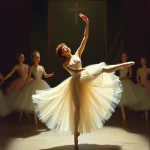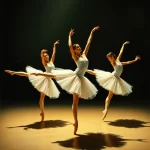Ballet: Mayerling (Franz Liszt, 1978)

Introduction
Ballet: Mayerling, choreographed by Kenneth MacMillan and set to the music of Franz Liszt, premiered in 1978. This ballet is a dramatic portrayal of the tragic events surrounding the Mayerling incident, a historical event involving the murder-suicide of Crown Prince Rudolf of Austria and his lover, Baroness Mary Vetsera. The ballet is renowned for its intense emotional depth, complex characters, and intricate choreography, making it a significant work in the world of dance.
Historical Background
Creation and Development
The creation of Mayerling took place in a period marked by a renewed interest in historical and psychological narratives in the arts. The 1970s saw a shift towards more complex and darker themes in ballet, moving away from the traditional fairy-tale stories. Kenneth MacMillan, known for his innovative and often controversial works, was inspired by the real-life events of the Mayerling incident, which had already been the subject of various literary and cinematic adaptations.
MacMillan collaborated with composer John Lanchbery, who adapted and orchestrated the music of Franz Liszt for the ballet. The choice of Liszt’s music, known for its romantic and dramatic qualities, perfectly complemented the intense and tragic storyline. The collaboration extended to other key figures, including designer Nicholas Georgiadis, whose sets and costumes added to the historical authenticity and emotional impact of the production.
Premiere and Reception
Mayerling premiered on February 14, 1978, at the Royal Opera House in London. The initial reception was mixed, with some critics praising the ballet’s boldness and emotional depth, while others found it too dark and complex. However, the audience response was generally positive, and the ballet quickly gained a reputation for its challenging choreography and powerful storytelling.
Notable early performances included those by David Wall as Crown Prince Rudolf and Lynn Seymour as Mary Vetsera, whose portrayals were widely acclaimed. The ballet has since been revived numerous times, with each production bringing new interpretations and insights into the characters and story.
Synopsis of the Ballet
Act I Summary
The ballet opens with the wedding of Crown Prince Rudolf and Princess Stephanie. Despite the festive atmosphere, it is clear that Rudolf is deeply troubled. He is haunted by visions of death and is increasingly drawn to the darker aspects of life. The act introduces key characters, including Rudolf’s mother, Empress Elisabeth, and his mistress, Countess Larisch, who plays a pivotal role in his descent into madness.
Act II Summary
In the second act, Rudolf’s behavior becomes more erratic. He engages in a series of affairs and becomes involved in political conspiracies. His relationship with Mary Vetsera intensifies, and they form a suicide pact. The act is marked by dramatic confrontations and emotional turmoil, culminating in a powerful pas de deux between Rudolf and Mary.
Act III Summary
The final act takes place at Mayerling, Rudolf’s hunting lodge. The atmosphere is tense and foreboding as Rudolf and Mary prepare for their final moments together. The climax of the ballet is their double suicide, portrayed with harrowing intensity. The ballet concludes with a somber and reflective finale, underscoring the tragic inevitability of their fate.
Finale
The conclusion of Mayerling is both tragic and poignant. The ballet ends with the lifeless bodies of Rudolf and Mary, a stark reminder of the destructive power of obsession and despair. The final moments are underscored by Liszt’s haunting music, leaving a lasting impression on the audience.
Musical Composition
Composer’s Role
Franz Liszt, a renowned composer of the Romantic era, did not compose the music specifically for Mayerling. Instead, John Lanchbery adapted and orchestrated Liszt’s existing works to create a cohesive score for the ballet. Liszt’s music, known for its emotional depth and dramatic intensity, was an ideal choice for the dark and complex narrative of Mayerling.
Musical Themes and Motifs
The score of Mayerling features several recurring musical themes and motifs that enhance the narrative and emotional impact of the ballet. For example, Liszt’s “Funérailles” is used to underscore Rudolf’s obsession with death, while the “Liebestraum” theme highlights the doomed romance between Rudolf and Mary. The music serves to deepen the audience’s connection to the characters and their tragic story.
Famous Recordings and Performances
There have been several notable recordings and performances of Mayerling’s music. One of the most acclaimed is the Royal Ballet’s 1994 production, conducted by Barry Wordsworth. This recording captures the emotional intensity and dramatic power of Liszt’s music, making it a favorite among ballet enthusiasts.
Choreography and Dance
Choreographer’s Vision
Kenneth MacMillan’s vision for Mayerling was to create a ballet that delved deeply into the psychological and emotional complexities of its characters. His choreography is known for its dramatic intensity and intricate partnering work, which reflects the turbulent relationships and inner turmoil of the characters. MacMillan’s innovative approach to storytelling through dance has made Mayerling a landmark work in the ballet repertoire.
Signature Dance Numbers
One of the most iconic dance numbers in Mayerling is the pas de deux between Rudolf and Mary in Act II. This intense and passionate duet captures the depth of their relationship and their shared descent into madness. Another notable scene is the wedding pas de deux in Act I, which juxtaposes the outward celebration with Rudolf’s inner turmoil.
Notable Interpretations
Over the years, different productions of Mayerling have brought new interpretations to MacMillan’s choreography. Some have emphasized the political aspects of the story, while others have focused more on the psychological and emotional dimensions. Notable dancers who have portrayed Rudolf include David Wall, Edward Watson, and Steven McRae, each bringing their unique style and interpretation to the role.
Characters and Roles
Main Characters
- Crown Prince Rudolf: The troubled heir to the Austro-Hungarian throne, whose descent into madness drives the narrative.
- Mary Vetsera: Rudolf’s young lover, who becomes entangled in his dark world and ultimately joins him in a suicide pact.
- Countess Larisch: Rudolf’s mistress and confidante, who plays a key role in his downfall.
Supporting Characters
- Empress Elisabeth: Rudolf’s mother, whose strained relationship with her son adds to his emotional turmoil.
- Princess Stephanie: Rudolf’s wife, who is caught in a loveless and troubled marriage.
- Bratfisch: Rudolf’s loyal servant, who provides moments of levity amidst the darkness.
Famous Dancers
Notable dancers who have portrayed these roles include David Wall, Lynn Seymour, Edward Watson, and Natalia Osipova. Their performances have been widely acclaimed for their emotional depth and technical brilliance.
Cultural and Artistic Impact
Influence on Ballet and Dance
Mayerling has had a significant influence on the world of ballet and dance. Its complex characters and dark themes have inspired other choreographers to explore similar narratives. The ballet’s innovative choreography has also set a new standard for dramatic storytelling in dance.
Cultural Significance
The ballet’s portrayal of historical events and psychological depth has made it a significant work in popular culture. It has been referenced in literature, film, and other media, highlighting its enduring impact. The story of Mayerling continues to captivate audiences, making it a timeless piece of art.
Legacy and Revivals
Mayerling has been revived numerous times since its premiere, with each production bringing new insights and interpretations. Major revivals include those by the Royal Ballet, the Vienna State Ballet, and the Paris Opera Ballet. The ballet’s enduring popularity is a testament to its powerful storytelling and emotional depth.
Iconic Productions
Historic Productions
One of the most famous historical productions of Mayerling was the Royal Ballet’s 1978 premiere, featuring David Wall and Lynn Seymour. This production set the standard for future performances and remains a landmark in the ballet’s history.
Contemporary Productions
Recent productions of Mayerling have continued to explore new interpretations and innovations. The Royal Ballet’s 2018 revival, featuring Steven McRae and Natalia Osipova, received widespread acclaim for its emotional intensity and technical brilliance. Contemporary productions often incorporate modern design elements while staying true to MacMillan’s original vision.
Production Design
The production design of Mayerling plays a crucial role in creating the ballet’s dark and atmospheric world. Nicholas Georgiadis’s sets and costumes are known for their historical accuracy and emotional impact. The use of lighting and stage effects further enhances the dramatic intensity of the ballet.
Critical Reception and Reviews
Initial Critical Response
The initial critical response to Mayerling was mixed, with some critics praising its boldness and emotional depth, while others found it too dark and complex. However, the ballet quickly gained a reputation for its challenging choreography and powerful storytelling, earning a place in the ballet repertoire.
Modern Reviews
Contemporary critics and audiences continue to praise Mayerling for its emotional intensity and innovative choreography. The ballet is often cited as one of Kenneth MacMillan’s masterpieces and remains a favorite among ballet enthusiasts. Its relevance and popularity endure, making it a timeless work of art.
Fun Facts and Trivia
Behind-the-Scenes Stories
One interesting behind-the-scenes story involves the original cast’s intense preparation for their roles. David Wall and Lynn Seymour spent months researching the historical events and psychological aspects of their characters, adding depth and authenticity to their performances.
Notable Performers
Famous dancers associated with Mayerling include David Wall, Lynn Seymour, Edward Watson, and Natalia Osipova. Their performances have been widely acclaimed for their emotional depth and technical brilliance.
Trivia
- Mayerling is one of the few ballets that features a male lead in a deeply complex and psychologically challenging role.
- The ballet’s sets and costumes were designed to reflect the historical accuracy of the late 19th century Austro-Hungarian Empire.
- Franz Liszt’s music was chosen for its romantic and dramatic qualities, perfectly complementing the ballet’s intense narrative.
Conclusion
Summary of the Ballet’s Importance
Mayerling is a significant work in the world of ballet, known for its emotional depth, complex characters, and innovative choreography. It has had a lasting impact on the art form, inspiring other choreographers and captivating audiences with its powerful storytelling.
Final Thoughts
Mayerling remains a timeless piece of art, continuing to be performed and celebrated around the world. Its exploration of historical events and psychological complexities makes it a unique and compelling work. For those who have not yet experienced Mayerling, it is highly recommended to watch a performance or listen to the score to fully appreciate its beauty and intensity.
FAQ
What is the central theme of this ballet?
The central theme of Mayerling is the tragic descent into madness and despair of Crown Prince Rudolf, culminating in his murder-suicide with his lover, Mary Vetsera.
Who are the main characters in this ballet?
The main characters are Crown Prince Rudolf, Mary Vetsera, Countess Larisch, Empress Elisabeth, Princess Stephanie, and Bratfisch.
What is the most famous dance number in this ballet?
The most famous dance number is the pas de deux between Rudolf and Mary in Act II, known for its intense emotional and physical demands.
How long does a typical performance of this ballet last?
A typical performance of Mayerling lasts approximately two and a half hours, including intermissions.
Are there any modern adaptations of this ballet?
Yes, there have been several modern adaptations and revivals of Mayerling, each bringing new interpretations and insights into the ballet.
Why is this ballet considered important in the history of dance?
Mayerling is considered important for its innovative choreography, complex characters, and emotional depth. It has had a lasting impact on the art form and continues to be celebrated for its powerful storytelling.





